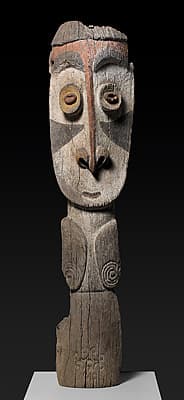
Papua New Guinea, East Sepik Province, Torembi Village
Mogulapan 18th to early 19th century wood, natural pigments , wood, ochres169.0 (h) x 40.0 (w) x 20.0 (d) cm National Gallery of Australia, Canberra NGA 1969.230.181
Mogulapan is a primordial ancestor in the creation stories of the Sawos people of the East Sepik Province. This fragmentary figure (the lower torso, arms and legs are missing and overall the figure was once of much greater height) was carved in the eighteenth or early nineteenth century from a dense wood using only tools of stone, shell and bone. His chest bears circular scarification designs and there are triangular designs on his cheeks. Mogulapan’s protruding eyes may represent those of a crocodile.
There is a large scorched area below the shoulder on the right that is said to be evidence of an historic event when a ceremonial house was stuck by lightning and caught fire.
Mogulapan is a primordial ancestor in the creation stories of the Sawos people of the East Sepik Province. This fragmentary figure (the lower torso, arms and legs are missing and overall the figure was once of much greater height) was carved in the eighteenth or early nineteenth century from a dense wood using only tools of stone, shell and bone. His chest bears circular scarification designs and there are triangular designs on his cheeks. Mogulapan’s protruding eyes may represent those of a crocodile.
There is a large scorched area below the shoulder on the right that is said to be evidence of an historic event when a ceremonial house was stuck by lightning and caught fire.
Mogulapan is a primordial ancestor in the creation stories of the Sawos people of the East Sepik Province. This fragmentary figure (the lower torso, arms and legs are missing and overall the figure was once of much greater height) was carved in the eighteenth or early nineteenth century from a dense wood using only tools of stone, shell and bone. His chest bears circular scarification designs and there are triangular designs on his cheeks. Mogulapan’s protruding eyes may represent those of a crocodile.
There is a large scorched area below the shoulder on the right that is said to be evidence of an historic event when a ceremonial house was stuck by lightning and caught fire.
